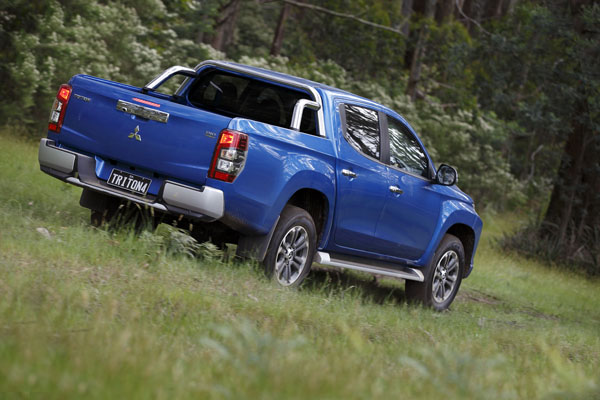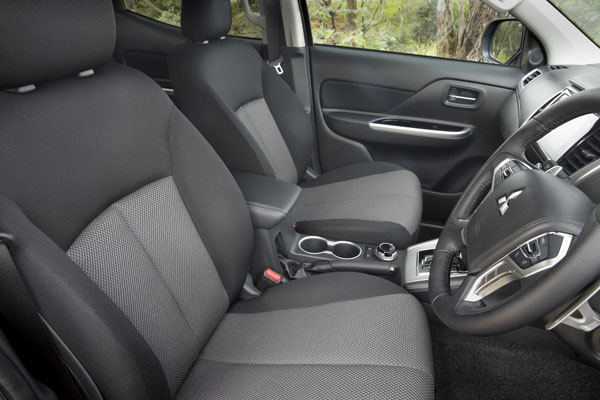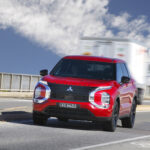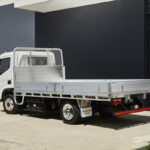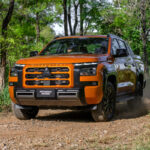
The Triton has carried the weight of Mitsubishi light truck expectations for more than 40 years, and with the model year ’19 range, there’s no sign of them being offloaded any time soon.
As I write this the Triton lies in overall third spot on the vehicle sales charts in Australia. Mitsubishi Australia is keen to keep its place in a weakened vehicle market, with the current model Triton, it says, combining the pick-up truck with passenger car levels of comfort for private and commercial purposes.
It carries over, and sees an evolution in, its Sport Utility Truck, with the durability required in commercial use and comfort and ride sought in private use.
The new Triton comes in three body styles – Dual Cab, taking in the function of a pick-up truck with the comfort of an SUV; Club Cab, skewed more to commercial use with double doors and space behind the front seats; and Single Cab, with the capacity for a long cargo tray and two seats resistant to dirt and hard wear.
There is a choice of two engines – a 2.4-litre turbo-diesel and similar-size petrol engine. A new six-speed automatic transmission is now available on diesel models. Two and four-wheel drive systems are offered across the range.
Prices start at $22,490 for the entry-level 4X2 GLX Single Cab Chassis 2.4-litre petrol manual, the 4×4 GLX Club Cab Chassis 2.4L diesel manual comes in at $35,490 and the 4×4 GLS Premium 2.4L Dual Cab Pick Up diesel auto tops off the range at $51,990. All are plus on-road costs. On test was the 4×4 GLX 2.4L Dual Cab Pick Up diesel auto, costing $39,990.
STYLING
For the new Triton, Mitsubishi has taken a leaf out of the American pick-up truck book (Ram etc) and adapted it to the company’s Dynamic Shield concept. Chrome is used to emphasise the power and toughness of the vehicle, while bonnet height and high positioning of the lamps reinforce the imposing look.
On a practical note, the headlamps and fog lamps are more than 700 mm above ground, making them less vulnerable to water damage or stones thrown up from other vehicles.
The rear lamp layout runs the full height of the bed and into the sides to accent width and depth of the cargo bed. Tail lamps are distinctive enough to identify the new Triton at a glance.
INTERIOR
Inside the double cab the black/grey interior has been upgraded to a sportier, higher-quality look monotone colour scheme. Soft-touch areas and contrasting stitching improve the look and feel to the driver’s hand.
The front seat armrest is also improved with double stitching in the soft knee pads on the floor console and on the console lid. The door trim uses thicker-gauge laminate and stitching, while double stitching is added to the parking brake lever and boot for a more substantial feel and improved looks.
Trays are provided at the bottom of the dash centre panel and there’s a USB charging socket in the floor console rear panel enabling rear passengers to charge devices.
INFOTAINMENT
The colour liquid crystal Multi Information Display, situated conveniently on the central dashboard, and a high-contrast meter cluster with higher definition dials than previously keep the driver in touch with systems and controls.
The audio system uses a high-quality 7-inch touchscreen and is Bluetooth compatible. AM/FM radio is available across all grades and DAB radio on GLX and GLS. All 7-inch models come with Android Auto and Apple CarPlay.
ENGINES / TRANSMISSIONS
Mitsubishi Triton is powered by a choice of two engines, the 2.4-litre turbo-diesel, producing maximum power output of 133 kW at 3500 rpm and maximum torque of 430 Nm at 2500 rpm. A six-speed automatic is now available on diesel models.
There’s also the offer of a 4G64 petrol engine with 94kW, and 194Nm at 4000rpm. it sits in front of a five-speed manual driving the rear wheels.
SAFETY
Mitsubishi Australia has upgraded safety to what it tells us is a higher level than rival pick-ups. It includes forward collision mitigation to detect vehicles and pedestrians ahead, while rear cross-traffic alert helps the driver check behind for other vehicles or pedestrians when reversing.
Blind spot warning with lane change assist comes to the aid of the driver when changing lanes and ultrasonic miss-acceleration mitigation helps prevent accidental use of the accelerator when moving off or reversing.
DRIVING
Mitsubishi has measured the fuel consumption at 8.6 litres per 100 kilometres on the combined urban / highway cycle. The test vehicle came closer to 10 litre per hundred.
The suspension is the same as before with minor changes bringing better directional stability. While the suspension strikes a balance between toughness and ride comfort, there is still some uncomfortable bobbing up and down on uneven road surfaces at speed.
Engineers put work into braking performance with the 18-inch wheels and feel is more positive than previously. Care has been taken to make occupants as comfortable as space will allow. Seats are well shaped and nicely padded.
Off road, the Triton GLX four-wheel drive keeps the Mitsubishi Easy Select system allowing the driver to switch simply between 2WD and 4WD on the move. Three transfer case settings – 2H, 4H, 4L – means the driver can switch between 2H and 4H on the fly at speeds less than 100 km/h.
At more than five metres long, with a turning circle of almost 12 metres, manoeuvring can be a chore. Width is a more manageable 1.8 metres. The tub will take loads of almost 1.5 metres square.
SUMMING UP
There’s no denying the Triton is trying to make up lost ground on rivals and while it seems safe at third place on the sales chart, it will need some canny selling to overhaul the two market leaders. The new seven-year warranty is a good start.
AT A GLANCE
MODEL LINE-UP
Triton Single Cab
4×2 GLX Cab Chassis 2.4L Man Petrol: $22,490
4×2 GLX Cab Chassis 2.4L Auto Diesel: $25,990
4×2 GLX Cab Chassis 2.4L Auto Diesel: $28,490
4×4 GLX Cab Chassis 2.4L Man Diesel: $32,990
4×4 GLX Cab Chassis 2.4L Auto Diesel: $35,490
Triton Club Cab
4×4 GLX Cab Chassis 2.4L Man Diesel: $35,490
4×4 GLX Cab Chassis 2.4L Auto Diesel: $38,790
4×4 GLX+ Cab Chassis 2.4L Man Diesel: $40,490
Triton Dual Cab
4×2 GLX ADAS Pick Up 2.4L Auto Diesel: $36,290
4×4 GLX Cab Chassis 2.4L Man Diesel: $36,240
4×4 GLX ADAS Cab Chassis 2.4L Auto Diesel: $39,540
4×4 GLX 2.4L Pick Up Man Diesel : $37,490
4×4 GLX 2.4L Pick Up Auto Diesel: $39,990
4×4 GLX ADAS 2.4L Pick Up Man Diesel: $38,290
4×4 GLX ADAS 2.4L Pick Up Auto Diesel: $40,790
4×4 GLX+ 2.4L Pick Up Man Diesel: $39,990
4×4 GLX+ 2.4L Pick Up Auto Diesel: $42,490
4×4 GLS 2.4L Pick Up Man Diesel: $44,490
4×4 GLS 2.4L Pick Up Auto Diesel: $46,990
4×4 GLS Premium 2.4L Pick Up Auto Diesel: $51,990
Note: These prices do not include dealer or government charges. Contact your local Mitsubishi dealer for drive-away prices.
SPECIFICATIONS (Triton GLX 2.4-litre four-cylinder turbo-diesel engine pick-up)
Capacity: 2442 cc
Configuration: 2.4-litre, 4 cylinder, 16-valve MIVEC intercooled common-rail turbo-diesel, six-speed automatic
Maximum Power: 133 kW @ 3500 rpm
Maximum Torque: 430 Nm @ 2500 rpm
Fuel type: Diesel
Combined Cycle (ADR 81/01): 8.6 litres per 100 km
CO2 emissions 225 g / km
DRIVELINE:
Drivetrain: Six-speed automatic with sports mode, Easy Select 4WD
DIMENSIONS, WEIGHT AND CAPACITIES:
Length: 5305 mm
Width: 1815 mm
Height: 1780 mm
Wheelbase: 3000 mm
Gross vehicle mass: 2900 kg
Fuel Tank Capacity: 75 litres
Turning circle: 11.8 m
BRAKES:
Front: Ventilated disc
Rear: Drum
WARRANTY:
Seven years / 150,000 kilometres




